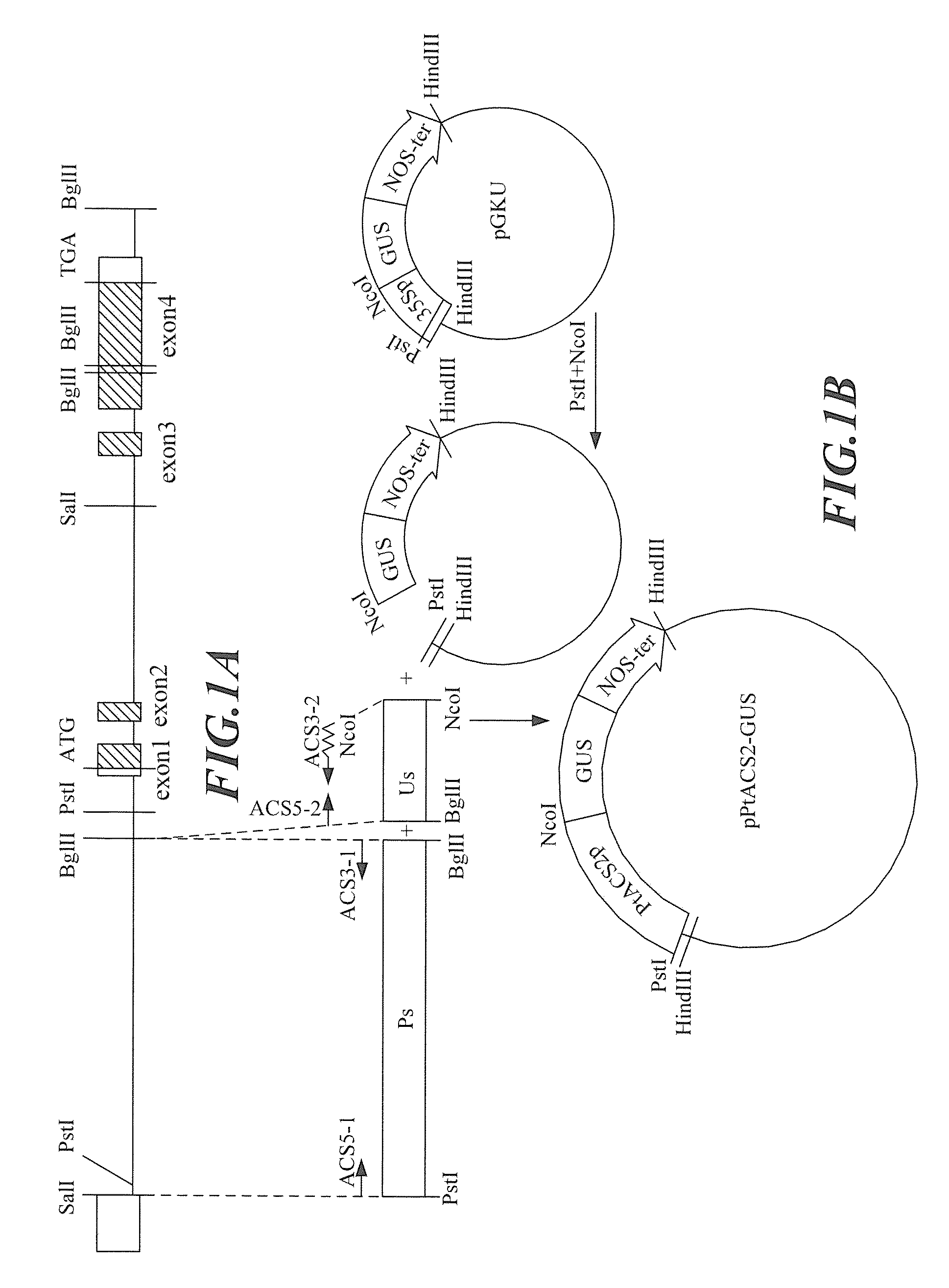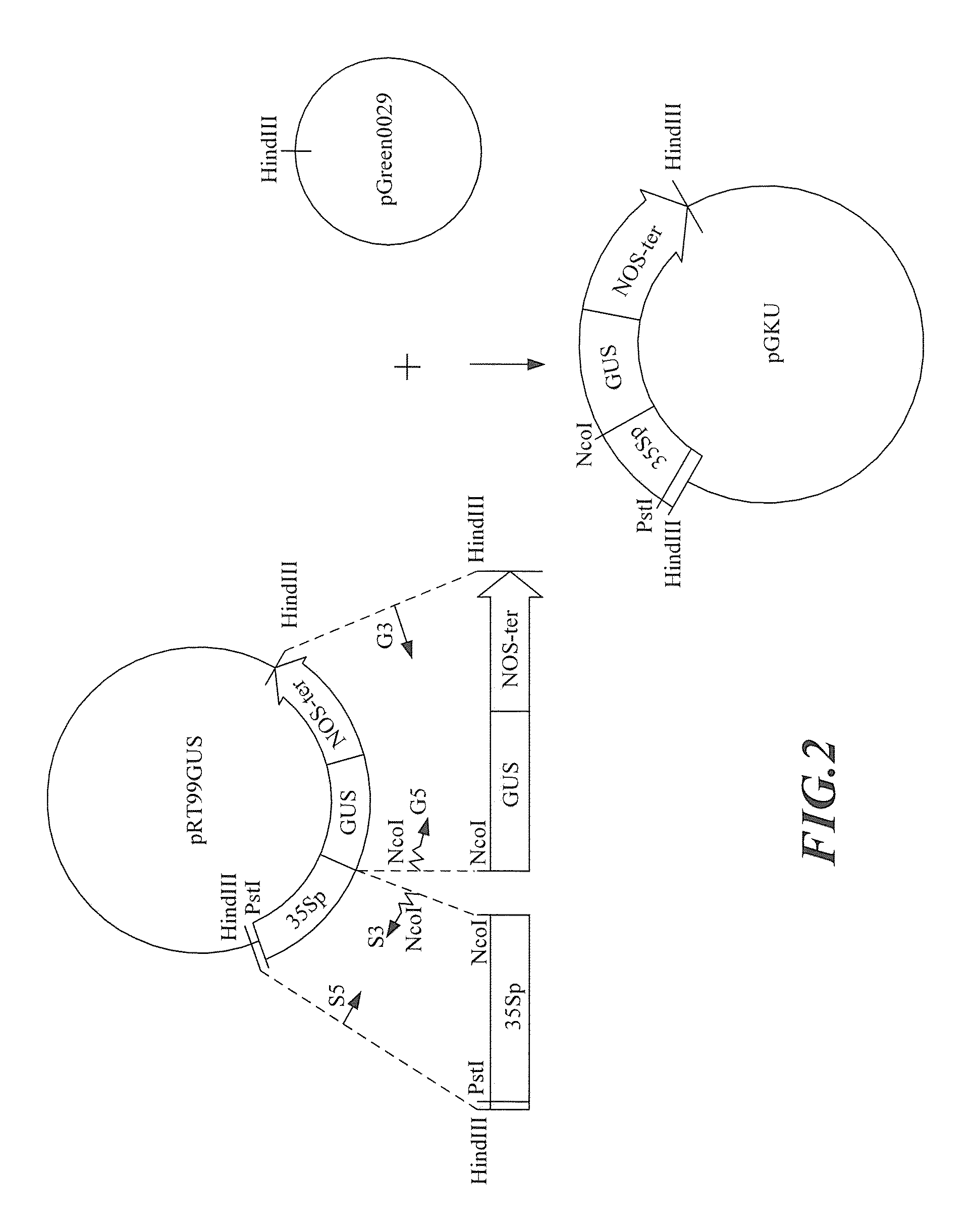Flower tissue-specific promoter and uses thereof
a tissue-specific promoter and gene technology, applied in the field of stretch of gene promoters, can solve the problems of transgenic target genes that cannot carry out the expression of target genes, and may interfere with the normal physiological processes of plants, and achieve the effect of altering the genetic constitution of transgenic plants
- Summary
- Abstract
- Description
- Claims
- Application Information
AI Technical Summary
Benefits of technology
Problems solved by technology
Method used
Image
Examples
example 1
Cloning of Phalaenopsis ACC Synthase Gene PtACS2 Promoter
1. The Sources of Phalaenopsis λEMBL3 Genomic Library
[0024]Phalaenopsis genomic library was prepared by extracting genomic DNA from leaves of a white with red lip Phalaenopsis True Lady, and then carrying out the construction of a genomic library through enzyme digestive replacement of DNA fragment by using bacteriophage λEMBL3 as the vector.
2. Preparation and Labeling of a Nucleic Acid Probe
[0025]A nucleic acid probe was prepared by using cDNA (with sequence as shown in SEQ ID No: 1) of Phalaenopsis ACC synthase gene PtACS2 (GeneBank accession number AF004663) as the template of the probe, carried out a process based on the principle of random primer labeling by means of Prime-a-gene kit (Stratagene). The total reaction volume was 50 μL, and the reaction mixture contained 1.2 μg / mL of a single-strand DNA fragment, 400 μg / mL of BSA, 20 μM dNTP (dAT P, dTTP, dGTP), 1 × labeling buffer, 50 μCi [α-32P] dCTP, 5 units of Klenow DNA...
example 2
Construction of a Vector Containing Phalaenopsis ACC Synthase Gene PtACS2 Promoter
[0030]The construction strategy of a vector containing Phalaenopsis ACC synthase gene PtACS2 promoter was shown in FIG. 1B. A 2,968 bp local sequence (SEQ ID No: 2) ahead of the translation start site of Phalaenopsis ACC synthase gene PtACS2 was used as the Phalaenopsis ACC synthase gene PtACS2 promoter (PtACS2p). Said promoter (PtACS2p) was constructed into the Agrobacterium transformation vector pGKU to replace the original CaMV 35S promoter (35Sp) in a manner that the 3′ end of the Phalaenopsis ACC synthase gene PtACS2 promoter (PtACS2p) sequence was linked to the 5′ end of the reporter gene β-glucuronidase (β-glucuronidase, GUS) gene sequence, so as to be used as the promoter for said reporter gene.
Step 1: Construction of Agrobacterium Transformation Vector pGKU
[0031]The construction strategy of Agrobacterium transformation vector pGKU was shown in FIG. 2. A fragment (CaMV 35S::GUS-NOS) was taken f...
example 3
Transformation of Arabidopsis thialana by Agrobacterium-Mediated Transformation Method
[0051]By using a model plant Arabidopsis thialana ecotype Columbia as starting material and employing Agrobacterium transformation, plasmid pPtACS2-GUS obtained in Example 2 was transformed into Arabidopsis thialana to change the genomic constitution of the transgenic plant such that Phalaenopsis ACC synthase gene PtACS2 promoter could start effectively the expression of the reporter gene GUS in the objective transgenic plant and also in progeny thereof. The expression site of the reporter gene GUS in Arabidopsis thialana transformant was analyzed by means of histochemical staining of GUS to detect whether Phalaenopsis ACC synthase gene PtACS2 promoter exhibited tissue specificity.
1. Preparation of Agrobacterium Liquor
[0052]The Agrobacterium tumefaciens EHA105 was inoculated in YEB solid medium (5 mg / L yeast extract, 10 g / L peptone, 10 g / L NaCl, 15 g / L Agar, pH 7.2) containing 100 μg / mL Rifamycin S...
PUM
| Property | Measurement | Unit |
|---|---|---|
| volume | aaaaa | aaaaa |
| pH | aaaaa | aaaaa |
| pH | aaaaa | aaaaa |
Abstract
Description
Claims
Application Information
 Login to View More
Login to View More - R&D
- Intellectual Property
- Life Sciences
- Materials
- Tech Scout
- Unparalleled Data Quality
- Higher Quality Content
- 60% Fewer Hallucinations
Browse by: Latest US Patents, China's latest patents, Technical Efficacy Thesaurus, Application Domain, Technology Topic, Popular Technical Reports.
© 2025 PatSnap. All rights reserved.Legal|Privacy policy|Modern Slavery Act Transparency Statement|Sitemap|About US| Contact US: help@patsnap.com



